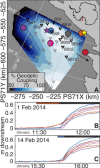Migratory earthquake precursors are dominant on an ice stream fault
- PMID: 33547072
- PMCID: PMC7864576
- DOI: 10.1126/sciadv.abd0105
Migratory earthquake precursors are dominant on an ice stream fault
Abstract
Simple fault models predict earthquake nucleation near the eventual hypocenter (self-nucleation). However, some earthquakes have migratory foreshocks and possibly slow slip that travel large distances toward the eventual mainshock hypocenter (migratory nucleation). Scarce observations of migratory nucleation may result from real differences between faults or merely observational limitations. We use Global Positioning System and passive seismic records of the easily observed daily ice stream earthquake cycle of the Whillans Ice Plain, West Antarctica, to quantify the prevalence of migratory versus self-nucleation in a large-scale, natural stick-slip system. We find abundant and predominantly migratory precursory slip, whereas self-nucleation is nearly absent. This demonstration that migratory nucleation exists on a natural fault implies that more-observable migratory precursors may also occur before some earthquakes.
Copyright © 2021 The Authors, some rights reserved; exclusive licensee American Association for the Advancement of Science. No claim to original U.S. Government Works. Distributed under a Creative Commons Attribution NonCommercial License 4.0 (CC BY-NC).
Figures




References
-
- Rice J. R., Ruina A. L., Stability of steady frictional slipping. J. Appl. Mech. 50, 343–349 (1983).
-
- Dieterich J. H., Earthquake nucleation on faults with rate- and state-dependent strength. Tectonophysics 211, 115–134 (1992).
-
- Tal Y., Hager B. H., Ampuero J. P., The effects of fault roughness on the earthquake nucleation process. J. Geophys. Res. Solid Earth 123, 437–456 (2018).
-
- McLaskey G. C., Earthquake initiation from laboratory observations and implications for foreshocks. J. Geophys. Res. Solid Earth 124, 12882–12904 (2019).
-
- Ruiz S., Metois M., Fuenzalida A., Ruiz J., Leyton F., Grandin R., Vigny C., Madariaga R., Campos J., Intense foreshocks and a slow slip event preceded the 2014 Iquique Mw 8.1 earthquake. Science 345, 1165–1169 (2014). - PubMed
LinkOut - more resources
Full Text Sources
Other Literature Sources

